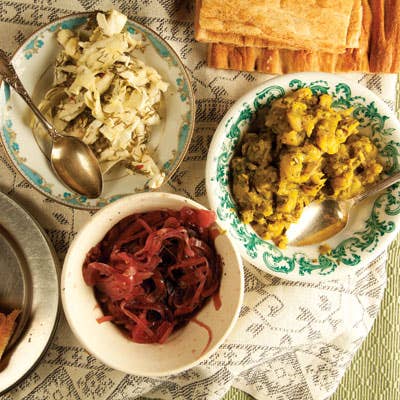
Sour and Sweet
This article first appeared in our March 2012 issue, with Anissa Helou’s story The Land of Bread and Spice.
Pickled vegetables or relishes, called torshi, appear often on the Persian table; they cut through the richness of roasted meats, stews, and soups and to bring balance to meals. Though the term comes from the Persian word torsh, which means sour, acidity is only one of the flavors that figures in these condiments. Torshi are made with a vast array of spices, aromatics, and herbs, such as mint, tarragon, and parsley, generous amounts of garlic, and sometimes a touch of sugar. The pickles gained popularity following the spread of Islam to Persia in the seventh century, when grapes, which were previously used to make wine, were transformed into vinegar instead (Islam forbids the consumption of alcohol). The tart liquid became a vital medium for preserving vegetables, and over time pickling became central to the Persian kitchen. While certain torshi ferment for only a few weeks and are eaten while still crisp and tart, others, such as the famed torshi-e seer, made with garlic, might age up to ten years, until the garlic turns soft and pungent. Torshi vary from region to region and kitchen to kitchen, but some types are universally popular.**** _
_
Torshi-e kalam, a sweet-tart slaw of sliced cabbage, dried chile flakes, and dill contrasts beautifully with Persian-style rice. See the recipe for Torshi-e Kalam »
Torshi-e piaz features thinly sliced onions pickled with coriander, nigella seeds, and tarragon, and is commonly served with kufteh, Persian meatballs. ****__**See the recipe for Torshi-e Piaz »**
Torshi-e liteh is creamy smashed marinated eggplant with parsley, cilantro, and tarragon, typically eaten with abgusht, a classic style of stew. See the recipe for Torshi-e Liteh »
Keep Reading
Continue to Next Story










